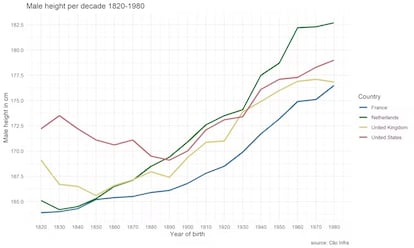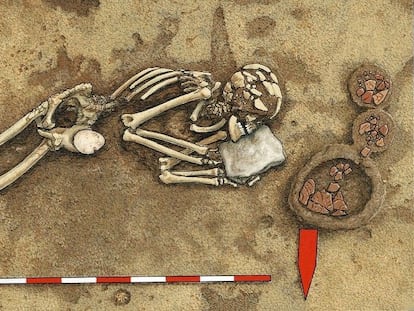How the Dutch became the tallest nation on Earth
While genetics undoubtedly plays a leading role in determining individuals’ heights, this tremendous change across an entire population cannot be explained by evolution alone

Studying the history of a country or region’s physical health is challenging, as consistently collected indicators of health are hard to come by. However, our recent study looked at the clear link between a population’s health and one simple, widely recorded piece of information — body height.
For most of human history, height remained relatively stable. Until 1800, the average height in Europe hovered between 165 cm and 170 cm, but over the past 200 years something remarkable has happened: heights, globally but particularly in Europe, have increased dramatically. Many European countries saw increases in average heights of over 15 cm, and this has been especially evident in the Netherlands — the average Dutch man has grown from 166 cm in 1810 to 184 cm today, an increase of 18 cm in just two centuries. Dutch men are currently the tallest in the world.

While genetics undoubtedly plays a leading role in determining individuals’ heights, this tremendous change across an entire population cannot be explained by evolution alone — if that were the case, the change in height would have occurred over a much longer timescale.
However, over the last 200 years the Netherlands has, like much of the rest of the world, experienced a huge improvement in all aspects of living standards, from reduced rates of excess mortality and infectious diseases, to greater access to high quality food. Their rapid increase in height therefore shows a clear link between living environments and healthier, taller populations.
Height, health and development
Body height and health are driven by similar factors during development, the most important being nutrition. To grow and be healthy, people need to fuel their bodies with food.
However, this energy can be sapped by other demands which divert it from growth — factors like illness, stress and heavy manual labor can all result in shorter populations.
Recent research shows that long-lasting or recurring illnesses were associated with shorter adult heights in the Netherlands in the 19th century, while shorter, one-off periods of illness may have actually been helpful for growth. This is likely because less severe illnesses boosted immunity against future infections.
The deaths of parents, particularly of mothers, have also been shown to result in shorter heights. For very young children, this would have been because they depend on their mothers for nutrition, but it was also true for older children, indicating the profound stress of losing a primary caregiver.
Curiously, although losing a mother was linked to shorter children’s heights — in the Netherlands and elsewhere — losing a father was not, potentially due to the gendered nature of parental care in this period.
Taken as a whole, height can therefore be seen as a reflection of the quality and quantity of food an individual consumed during development — and the absence of stressing factors that divert the energy derived from it — from birth until the end of puberty.
Height and health in adulthood
In terms of measuring health in adults, height is a more complex issue. Today, people above average height — men in particular — tend to have an overall lower risk of of death. However, extremely tall people (190 cm and taller) tend to have a slightly higher risk of death, mainly because they have an increased risk of cancer-related mortality. This is thought to be a question of body mass — taller bodies have more cells and more cell divisions, meaning a greater chance of developing cancer. Taller people also tend to eat more calories, which could also play a role.
When looking at historical (i.e. pre-World War II) populations, the findings are even more complex: taller people, both men and women alike, tended to die at younger ages, even those who would be considered relatively short today (such as women who are 155 cm).
Their increased mortality rates were likely because shorter people require fewer calories than their taller peers. In periods of food scarcity, which were more common in the past, shorter people were therefore at a lower risk of malnutrition.
In historical populations, infectious disease deaths were also more common than they are today, and the combination of these two factors meant an increased risk of death for taller people.
Tales of tallness today — and in the future
While our own research has focused on height’s relevance to the study of the past, it also has significant implications for healthcare today, especially in areas that are hard to reach or monitor. Currently, the World Health Organization collects data on child stunting, or whether or not a child has fallen behind on what is considered a healthy growth curve. This data is widely used to estimate levels of malnutrition within a country or region.
In the Netherlands, children are now shorter than their parents, but it is unclear what has caused the giants of the modern world to shrink. This begs a number of serious questions: Has diet quality declined? Is childhood obesity impeding growth? Unraveling why populations grow — or shrink — may help us to understand health on a national, rather than individual level.
Kristina Thompson is assistant professor in Health & Society, at Wageningen University.
Björn Quanjer is a postdoctoral researcher at Radboud University.
This article was originally published in The Conversation.
Sign up for our weekly newsletter to get more English-language news coverage from EL PAÍS USA Edition
Tu suscripción se está usando en otro dispositivo
¿Quieres añadir otro usuario a tu suscripción?
Si continúas leyendo en este dispositivo, no se podrá leer en el otro.
FlechaTu suscripción se está usando en otro dispositivo y solo puedes acceder a EL PAÍS desde un dispositivo a la vez.
Si quieres compartir tu cuenta, cambia tu suscripción a la modalidad Premium, así podrás añadir otro usuario. Cada uno accederá con su propia cuenta de email, lo que os permitirá personalizar vuestra experiencia en EL PAÍS.
¿Tienes una suscripción de empresa? Accede aquí para contratar más cuentas.
En el caso de no saber quién está usando tu cuenta, te recomendamos cambiar tu contraseña aquí.
Si decides continuar compartiendo tu cuenta, este mensaje se mostrará en tu dispositivo y en el de la otra persona que está usando tu cuenta de forma indefinida, afectando a tu experiencia de lectura. Puedes consultar aquí los términos y condiciones de la suscripción digital.
More information
Últimas noticias
Maduro pleads not guilty before the federal court in New York: ‘I am still the president of Venezuela’
A new test can detect Alzheimer’s from a finger prick
UN team enters Sudanese city of El Fasher after paramilitary massacre: ‘It’s like a ghost town’
A recipe for resistance: Indigenous peoples politicize their struggles from the kitchen
Most viewed
- Gilles Lipovetsky: ‘If you want to live better and fall in love, take Prozac, don’t look to philosophy’
- Alain Aspect, Nobel laureate in physics: ‘Einstein was so smart that he would have had to recognize quantum entanglement’
- Maduro’s downfall puts China’s relationship with Venezuela to the test
- Why oil has been at the center of Venezuela-US conflicts for decades
- Alvin Hellerstein, a 92-year-old judge appointed by Bill Clinton, to preside over Maduro’s trial in New York










































